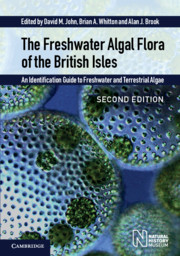 The Freshwater Algal Flora of the British Isles
The Freshwater Algal Flora of the British Isles Book contents
- Frontmatter
- Contents
- The online material (formerly provided in DVD format)
- List of Contributors
- Foreword
- Preface
- Acknowledgements
- Introduction
- Distribution and Ecology
- History of Freshwater Algal Studies in the British Isles
- Field Methods
- Laboratory Methods
- Water Framework Directive
- Cultures of British Freshwater Algae
- Classification
- Key to phyla
- Cyanobacteria (Cyanophyta)
- Phylum Rhodophyta (Red Algae)
- Phylum Euglenophyta (Euglenoids)
- Phylum Cryptophyta (Cryptomonads)
- Phylum Dinophyta (Dinoflagellates)
- Phylum Raphidophyta
- Phylum Haptophyta (Prymnesiophyta)
- Phylum Chrysophyta (Golden Algae)
- Phylum Xanthophyta (Tribophyta) (Yellow-Green Algae)
- Phylum Eustigmatophyta
- Phylum Bacillariophyta (Diatoms)
- Phylum Phaeophyta (Brown Algae)
- Primitive Green Algae (‘PRASINOPHYTA’)
- Phylum Chlorophyta (Green Algae)
- Phylum Glaucophyta
- Glossary
- Standard Form of Authors of Algal Names
- Sources of Illustrations or Material
- References
- Taxonomic Index
- Subject Index
- Plate Saction
- Miscellaneous Endmatter
- Miscellaneous Endmatter
Phylum Bacillariophyta (Diatoms)
Published online by Cambridge University Press: 12 January 2024
- Frontmatter
- Contents
- The online material (formerly provided in DVD format)
- List of Contributors
- Foreword
- Preface
- Acknowledgements
- Introduction
- Distribution and Ecology
- History of Freshwater Algal Studies in the British Isles
- Field Methods
- Laboratory Methods
- Water Framework Directive
- Cultures of British Freshwater Algae
- Classification
- Key to phyla
- Cyanobacteria (Cyanophyta)
- Phylum Rhodophyta (Red Algae)
- Phylum Euglenophyta (Euglenoids)
- Phylum Cryptophyta (Cryptomonads)
- Phylum Dinophyta (Dinoflagellates)
- Phylum Raphidophyta
- Phylum Haptophyta (Prymnesiophyta)
- Phylum Chrysophyta (Golden Algae)
- Phylum Xanthophyta (Tribophyta) (Yellow-Green Algae)
- Phylum Eustigmatophyta
- Phylum Bacillariophyta (Diatoms)
- Phylum Phaeophyta (Brown Algae)
- Primitive Green Algae (‘PRASINOPHYTA’)
- Phylum Chlorophyta (Green Algae)
- Phylum Glaucophyta
- Glossary
- Standard Form of Authors of Algal Names
- Sources of Illustrations or Material
- References
- Taxonomic Index
- Subject Index
- Plate Saction
- Miscellaneous Endmatter
- Miscellaneous Endmatter
Summary
Introduction
The Bacillariophyta are a highly distinctive group of algae which exist as single cells, colonies or filaments. Their characteristics, as seen under the light microscope, include a unique cell wall of silica (termed a ‘frustule’) and golden-brown plastids, caused by the presence of the carotenoid fucoxanthin alongside chlorophylls a and c2. The diatom frustule is essentially of two parts, each having a valve adjoined by one or more girdle bands (termed ‘cingula’) that allow for expansion and cell division. When seen in a medium of high refractive index, the valves are extremely beautiful and this has attracted microscopists to their study almost since microscopes were invented. The vegetative cells lack flagella, but some diatoms are capable of gliding across surfaces, using a longitudinal slit in the valve termed a ‘raphe’. The Bacillariophyta are also characterized by several features visible only with electron microscopy: these are described at greater length in Round et al. (1990) and Hoek et al. (1995). Two main groups of diatoms are recognized: centric diatoms, which are radially symmetrical, and pennate diatoms which show longitudinal symmetry in at least one of three planes. The arrangement of the frustule around these planes is an important diagnostic character for pennate genera. The arrangement of structures on the valve surface also plays an important role for identifying both genera and species. These structures include the raphe, as well as many smaller perforations through which the diatom is connected to its environment.
Microscopists have studied diatoms since the late 1700s. However, the small size of the cells (most are <30 μm) coupled with the reliance on distinguishing surface ornamentation has meant that developments in diatom taxonomy have been limited by the technology available. The invention of apochromatic lenses and phase contrast techniques, the availability of better light sources and the development of mountant with high refractive indices all contributed to the ease with which features could be observed and species distinguished. This evolving taxonomic interpretation has caused many name changes – with lumping, splitting and recombination of both species and genera. The first comprehensive account of freshwater diatoms from the British Isles was W. Smith’s A Synopsis of the British Diatomaceae, published between 1853 and 1856. This included 43 genera and 284 species.
- Type
- Chapter
- Information
- The Freshwater Algal Flora of the British IslesAn Identification Guide to Freshwater and Terrestrial Algae, pp. 348 - 353Publisher: Cambridge University PressPrint publication year: 2021
